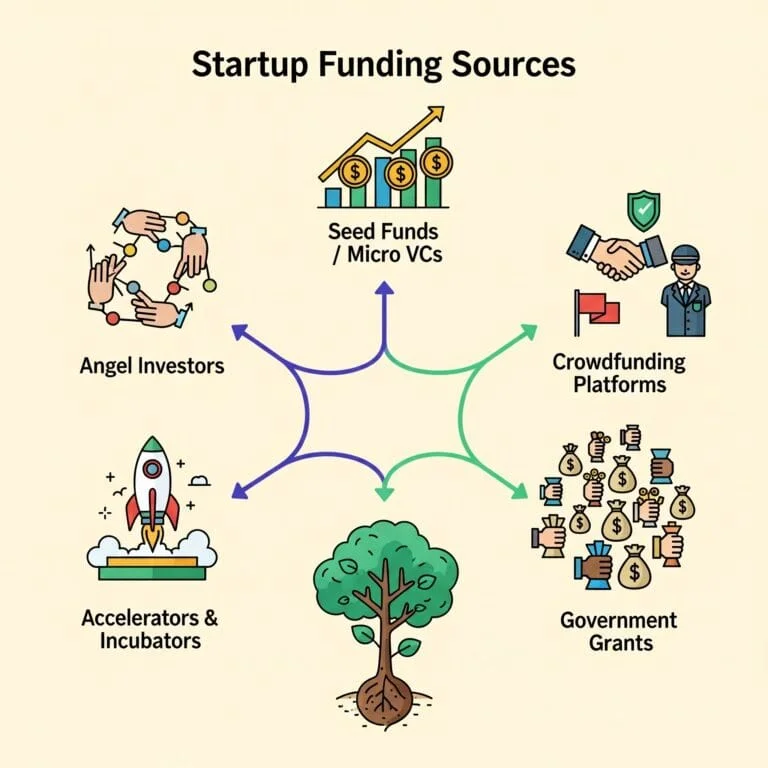Table of content
What is Seed Funding?
Seed funding is the initial capital raised by a startup to develop its business idea before generating significant revenue. The term “seed” represents the early stage of business growth, where capital acts as a foundation for expansion.
Key uses of seed funding include:
- Product development and MVP creation
- Market research and customer validation
- Hiring early team members
- Building initial traction and user base
- Establishing business operations
The name comes from the idea that this early capital is the “seed” from which a business can grow into a larger company.

UK Seed Funding Market Statistics 2025
Understanding the current market landscape is crucial for UK founders seeking seed investment.
1. Market Size and Growth
- Total UK seed funding in 2024: approximately £2.04 bn, a 24% increase from £1.64 bn in 2023
2. Industry Breakdown
Based on 2023–2024 venture investment trends in the UK:
- FinTech: regained top spot in 2024 after reclaiming dominance
- CleanTech/ClimateTech: fastest growing among funded sectors, accounting for 29% of VC investment in 2023
3. Geographic Distribution
From Beauhurst’s H1 2024 data:
- London: 61.8% of equity funding, and 47.2% of deals
- Scotland: 10.2% of deals
North West (e.g., Manchester/Liverpool): 10.9% of funding

Who Provides Seed Investment?
Angel Investors
- Investment range: £25K–£250K
- What they offer: Personal funds, industry expertise, networks
- Best for: Early-stage startups with proven founders
- UK Business Angels Association
Read: Angel Investors vs Venture Capitalists
Seed Funds / Micro VCs
- Investment range: £100K–£2M
- What they offer: Institutional capital, structured support
- Examples:
Read: How to Approach VCs

Accelerators & Incubators
- Investment range: £15K–£150K
- What they offer: Funding plus mentorship, and networks
- Examples:
- Techstars London
- Entrepreneur First
Crowdfunding Platforms
Read: Crowdfunding for Startups
Government Grants
- Investment range: £10K–£200K
- What they offer: Non-dilutive funding with tax benefits
- Programs:
- EIS (Enterprise Investment Scheme)
- Innovate UK
Read: Small Business Funding Options
Friends & Family
- Investment range: £5K–£50K
- What they offer: Initial capital from trusted networks
- Best for: Very early-stage proof of concept
Read: Raising Startup Funds from Friends & Family — Dos & Don’ts
How to Align with Investor Expectations
- Market Size and Opportunity
- Expectation: Addressable market of £1B+ with clear growth trajectory
- How to align: Present TAM, SAM, and SOM with validation data
- Strong Founding Team
- Expectation: Complementary skills and full-time commitment
- How to align: Highlight relevant experience and clear role definitions
- Traction and Validation
- Expectation: Evidence of product-market fit and customer demand
- How to align: Provide user metrics, testimonials, and retention data
- Scalable Business Model
- Expectation: Clear path to profitability and revenue growth
- How to align: Present unit economics and 3-year projections

- Competitive Advantage
- Expectation: Defensible moat and differentiation
- How to align: Show unique value proposition and barriers to entry
- Exit Potential
- Expectation: 10x+ return potential within 5-7 years
- How to align: Research comparable exits and potential acquirers
Is Your Startup Ready for Seed Funding?
Essential Prerequisites Checklist
- Clear problem-solution fit with validated customer pain points
- Basic MVP (Minimum Viable Product) or working prototype
- Market validation (waitlist signups, early users, customer interviews)
- Committed founding team with complementary skills
- Initial business plan with clear funding allocation strategy
- Legal structure (UK Limited Company for equity investment)
Advanced Readiness Indicators
- Early traction metrics showing user engagement
- Customer feedback loops and product iteration cycles
- Competitive analysis and market positioning
- Financial projections with realistic assumptions
- Team expansion plan for key hires
If you’re missing several of these, focus on building your MVP and gaining initial traction before approaching investors.

- Competitive Advantage
- Expectation: Defensible moat and differentiation
- How to align: Show unique value proposition and barriers to entry
- Exit Potential
- Expectation: 10x+ return potential within 5-7 years
- How to align: Research comparable exits and potential acquirers
Alternative Funding Mechanisms
1. Revenue-Based Financing (RBF)
- How it works: Investors provide capital for a percentage of future revenue
- Best for: SaaS companies with predictable recurring revenue
- UK providers: Uncapped, Karmen
2. Convertible Instruments
Simple Agreement for Future Equity (SAFE):
- Faster to close than priced rounds
- Converts to equity in future funding round
- Popular with accelerators and angel investors
Convertible Loans:
- Debt that converts to equity
- Include interest rates and conversion discounts
- Common in the UK, seed funding
3. Equity Crowdfunding
- Platforms: Seedrs, Crowdcube
- Benefits: Access to retail investors, marketing benefits
- Regulation: FCA-regulated with investor protections
4. Government Funding
- Innovate UK Grants: Up to £200K for innovative projects
- SEIS Tax Relief: Up to £150K annually with tax benefits
- EIS Tax Relief: Up to £5M annually
Seed vs Pre-Seed vs Series A Funding
| Stage | Typical Funding (UK) | Investor Types | Primary Focus | Equity Dilution |
|---|---|---|---|---|
| Pre‑Seed | £50K–£350K | Founders & Friends/Family, Angel investors, Accelerators | Idea validation, MVP | 10–20% |
| Seed | £500K–£2M | Angels, Micro‑VCs, Seed funds | MVP + early traction, team building | ~20% (range 15–25%) |
| Series A | £2M–£10M | VC firms, Growth investors | Scaling and go‑to‑market | ~20% (range 15–25%) |
- Pre‑Seed (Friends & Family): In the UK, typical pre‑seed rounds range from £50K–£250K, and equity dilution usually sits between 10–20%.
- Series A Rounds: Usually around £2M–£10M, with similar dilution levels (~20%, range 15–25%).
Key Differences Explained
Pre-Seed Focus:
- Proving concept viability
- Building an initial prototype
- Conducting market research
- Assembling the founding team
Seed Focus:
- Achieving product-market fit
- Building an initial customer base
- Hiring key team members
- Establishing a business model
Series A Focus:
- Scaling a proven business model
- Expanding market reach
- Building sales and marketing teams
- Preparing for rapid growth
Key Differences Explained
- Seed funding ranges: £100K–£2M for most UK startups
- Equity expectations: 15-25% dilution is standard
- Timeline: Allow 4-6 months for the fundraising process
- Readiness: Have an MVP, traction, and a clear business model
- Alternative options: Consider RBF, convertible instruments, and government grants
Final Thoughts on Securing Seed Investment
Seed funding isn’t just about raising money—it’s about finding the right partners to support your startup journey. The UK startup ecosystem continues to evolve, with new funding mechanisms and investor types emerging regularly.
Focus on building a business that creates real value for customers, maintain strong relationships with potential investors, and remember that fundraising is a means to an end, not the end itself. Use seed funding strategically to achieve key milestones that will position your startup for future growth and success.
Ready to take the next step? Contact us today to discuss your seed funding strategy and how we can support your startup’s growth journey.
Conclusion
Technical debt represents a critical aspect of software development that balances short-term needs against long-term sustainability. Organisations that understand what creates technical debt, how to measure technical debt, and how to manage technical debt gain competitive advantages through more sustainable development practices.
The key to success lies not in avoiding technical debt entirely, which is rarely possible, but in making conscious decisions about when to take on debt, tracking it diligently, and allocating resources to pay it down strategically.
By proactively addressing technical debt, development teams can maintain velocity, improve quality, and ensure their software remains adaptable to changing business needs.
Need help auditing or reducing technical debt? Talk to our development experts today.
Frequently Asked Questions (FAQs)
What counts as seed funding in the UK?
How much equity do startups give up in seed rounds?
How long does it take to close a seed funding round?
4-6 months from initial outreach to funding completion, including 2-3 months for preparation and 2-3 months for active fundraising.
Can you get seed funding without revenue?
Yes, many seed-stage companies are pre-revenue. Focus on demonstrating traction through user metrics, partnerships, or market validation rather than revenue.
What documents do I need for seed funding?
- Executive summary (2 pages)
- Pitch deck (10-15 slides)
- Financial projections (3 years)
- Product demo or prototype
- Legal documentation (articles of incorporation, cap table)
What's the difference between angel investors and VCs?
Angel investors invest personal funds and typically write smaller checks (£25K–£100K). VCs manage institutional funds and write larger checks (£100K–£2M+).








